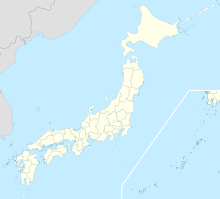
Back Narita Internasionale Lughawe Afrikaans مطار ناريتا الدولي Arabic مطار ناريتا الدولى ARZ Aeropuertu Internacional de Narita AST Narita Beynəlxalq Hava Limanı Azerbaijani নারিতা আন্তর্জাতিক বিমানবন্দর Bengali/Bangla Aeroport Internacional de Narita Catalan Narita International Airport CEB Mezinárodní letiště Narita Czech Narita International Airport Danish
Tokyo-Narita International Airport 成田国際空港 Narita Kokusai Kūkō | |||||||||||||||||||
|---|---|---|---|---|---|---|---|---|---|---|---|---|---|---|---|---|---|---|---|
 | |||||||||||||||||||
 Aerial view of NRT in 2008 | |||||||||||||||||||
| Summary | |||||||||||||||||||
| Airport type | Public | ||||||||||||||||||
| Owner/Operator | Narita International Airport Corporation (NAA) | ||||||||||||||||||
| Serves | Greater Tokyo Area | ||||||||||||||||||
| Location | Narita, Chiba Prefecture, Japan | ||||||||||||||||||
| Opened | May 20, 1978 | ||||||||||||||||||
| Hub for | |||||||||||||||||||
| Operating base for | |||||||||||||||||||
| Elevation AMSL | 41 m / 135 ft | ||||||||||||||||||
| Coordinates | 35°45′55″N 140°23′08″E / 35.76528°N 140.38556°E | ||||||||||||||||||
| Website | www | ||||||||||||||||||
| Maps | |||||||||||||||||||
 | |||||||||||||||||||
| Runways | |||||||||||||||||||
| |||||||||||||||||||
| Statistics (2023) | |||||||||||||||||||
| |||||||||||||||||||
Narita International Airport (成田国際空港, Narita Kokusai Kūkō) (IATA: NRT, ICAO: RJAA), also known as Tokyo-Narita International Airport or simply Narita Airport, formerly and originally known as New Tokyo International Airport (新東京国際空港, Shin Tōkyō Kokusai Kūkō), is one of two international airports serving the Greater Tokyo Area, the other one being Haneda Airport (HND). It is about 60 km (37 mi) east of central Tokyo in Narita, Chiba.[2] The facility, since July 2019, covers 1,137 hectares (2,810 acres) of land and construction to expand to nearly 2,300 ha (5,700 acres) is under way.[3]
The conceptualization of Narita was highly controversial and remains so to the present day, especially among local residents in the area. This has led to the Sanrizuka Struggle, stemming from the government's decision to construct the airport without consulting most residents in the area, as well as expropriating their lands in the process. Even after the airport was eventually completed, air traffic movements have been controlled under various noise related operating restrictions due to its direct proximity with residential neighborhoods, including a house with a farm that is located right in between the runways.[4] As a result, the airport must be closed from 00:00 (12:00am) to 06:00 (6:00am) the next day to minimize the noise pollution impact around the airport.[5]
Narita is the busiest airport in Japan by international passenger and international cargo traffic.[6] In 2018, Narita had 33.4 million international passengers and 2.2 million tonnes of international cargo.[7] In 2018, Narita was also the second-busiest airport in Japan in terms of aircraft movements (after Haneda Airport in Tokyo)[7] and the tenth-busiest air freight hub in the world.[8] Its 4,000-meter (13,123 ft) main runway shares the record for longest runway in Japan with the second runway at Kansai International Airport in Osaka.[9] Narita serves as the main international hub of Japan Airlines, All Nippon Airways and Nippon Cargo Airlines, United Airlines, and as an operating base for low-cost carriers Air Japan, Jetstar Japan, Peach Aviation, Spring Airlines Japan, and Zipair Tokyo.
In 2022, Narita was named the fourth-best airport in the world after Hamad International Airport in Doha, Haneda Airport in Tokyo, and Changi Airport in Singapore, by Skytrax’s World’s Top 100 airports.
- ^ "NARITA AIRPORT TRAFFIC STATISTICS -2022(JAN-DEC)" (PDF; 578 KB). naa.jp. Narita International Airport Corporation. 2023-01-26. Retrieved 2023-02-09.
- ^ "Location". Narita International Airport Corporation. Archived from the original on 2 December 2014. Retrieved 15 May 2015.
- ^ "Layout, Main Facilities at Narita Airport". naa.jp. Retrieved October 16, 2023.
- ^ Craft, Lucy; Novak, Analisa (2023-08-22). "Japanese farmer has fought for decades to stay on his ancestral land in the middle of Narita airport - CBS News". www.cbsnews.com. Retrieved 2024-04-02.
- ^ "Relaxations of operating restrictions on Noise and resident's reaction at Narita International Airport" (PDF). Saburo Ogata (Narita International Airport Corporation), Naoaki Shinohara (Narita International Airport Promotion Foundation). Archived from the original (PDF) on 2019-04-13. Retrieved 2019-07-21.
- ^ "Narita International Airport". Japan Civil Aviation Bureau. Archived from the original on 30 December 2009. Retrieved 15 May 2015.
- ^ a b "平成30年(暦年)空港別順位表" (in Japanese). Ministry of Land, Infrastructure, Transport and Tourism. Archived from the original on 30 April 2020. Retrieved 23 May 2020.
- ^ "ACI reveals top 20 airports for passenger traffic, cargo, and aircraft movements". Airports Council International. March 19, 2020. Archived from the original on 2020-05-25. Retrieved 2020-05-23.
- ^ "Narita and Haneda: Two Airports in the Tokyo Metropolitan Area". Japan Aerospace Exploration Agency. Archived from the original on 7 December 2015. Retrieved 15 May 2015.


